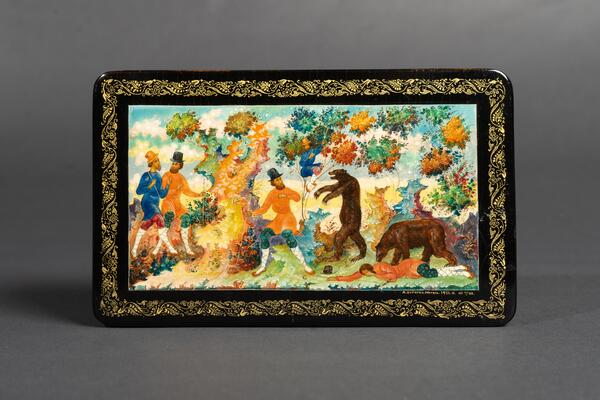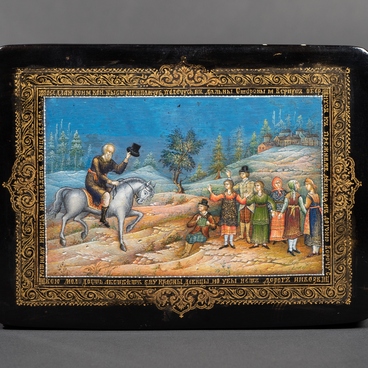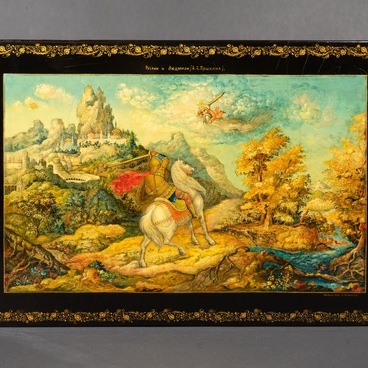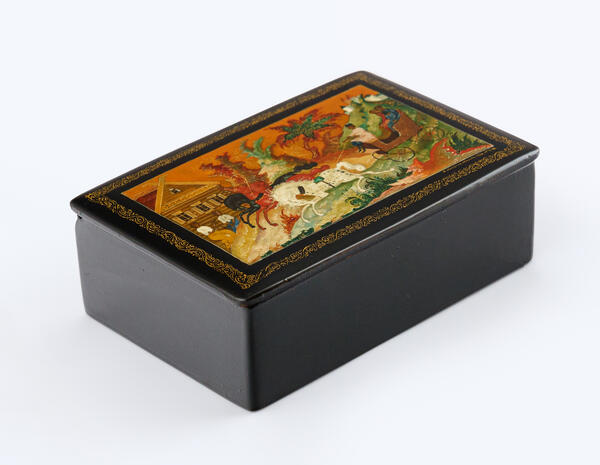The plot of Leo Tolstoy’s short fable “Two Friends” is depicted in the miniature “The Parable of Two Men”. It is a story about two friends who were walking in the woods and suddenly encountered a bear. One man ran away and climbed up a tree, while the other stayed on the road. There was nothing else he could do — he threw himself to the ground and pretended to be dead. The bear sniffed his face and went away. Then his friend got down from the tree and, started to laugh and asked: “Well, what did the bear whisper in your ear?” The answer was: “He told me that it is an evil person who runs away when a friend is in danger.”
The miniature was painted by Alexander Kotyagin, a former prominent master of icon painting, a well-known restorer of Old Russian paintings and one of the founders of the Mstyora lacquer miniature. He was one of the first miniaturists who started to depict contemporary events. A significant part of the artist’s works, however, is based on the plots of fairy tales and other literary works.
The artist’s unique style clearly manifested in this painting. The master divided the composition into a number of scenes, in which he consecutively depicted the plot of the fable. This technique, in which two or more moments from the narrative are shown within a single image, is often used in icon painting and frescoes, when the task is to visually demonstrate the events of Sacred history and the lives of saints.
The master depicted two peasants walking along a forest road in the left part of the miniature. Slender trees on elegant decorative hills, similar to landscapes depicted on icons, symbolize a wooded area.
In the center, the artist placed the exposition of the fable: a bear appears in front of the two friends, he rises menacingly on his hind legs. This composition is inspired by the popular 18th century lubok print the “Hunting with a Bear Spear”. Like other Mstyora artists, the master often used the motifs from lubok prints, which vividly and humorously represented folk life.
The climax of the fable is depicted on the right: while one man hides in a tree, the bear peacefully sniffs the other man who has fallen to the ground.
Alexander Kotyagin masterfully worked out the composition. He used the technique of painting with transparent and at the same time bright colors: that is how he achieved an effect similar to enamel painting. He painted the figures of peasants with expressive, elegant lines; and for the landscape he brought in stylized decorative features and used rich elaborate color combinations.
The miniature was painted by Alexander Kotyagin, a former prominent master of icon painting, a well-known restorer of Old Russian paintings and one of the founders of the Mstyora lacquer miniature. He was one of the first miniaturists who started to depict contemporary events. A significant part of the artist’s works, however, is based on the plots of fairy tales and other literary works.
The artist’s unique style clearly manifested in this painting. The master divided the composition into a number of scenes, in which he consecutively depicted the plot of the fable. This technique, in which two or more moments from the narrative are shown within a single image, is often used in icon painting and frescoes, when the task is to visually demonstrate the events of Sacred history and the lives of saints.
The master depicted two peasants walking along a forest road in the left part of the miniature. Slender trees on elegant decorative hills, similar to landscapes depicted on icons, symbolize a wooded area.
In the center, the artist placed the exposition of the fable: a bear appears in front of the two friends, he rises menacingly on his hind legs. This composition is inspired by the popular 18th century lubok print the “Hunting with a Bear Spear”. Like other Mstyora artists, the master often used the motifs from lubok prints, which vividly and humorously represented folk life.
The climax of the fable is depicted on the right: while one man hides in a tree, the bear peacefully sniffs the other man who has fallen to the ground.
Alexander Kotyagin masterfully worked out the composition. He used the technique of painting with transparent and at the same time bright colors: that is how he achieved an effect similar to enamel painting. He painted the figures of peasants with expressive, elegant lines; and for the landscape he brought in stylized decorative features and used rich elaborate color combinations.





